Laptop Mag Verdict
The Asus VivoBook Flip 14 is a sub-$500 2-in-1 with a flexible design and clean looks, but its poor performance and awful webcam give us pause.
Pros
- +
Flexible 2-in-1 design
- +
Clean, stylish looks
- +
Stylus included
Cons
- -
Underwhelming performance
- -
Uneven build quality
- -
Poor webcam
- -
Lots of bloatware
Why you can trust Laptop Mag
As a sub-$500 convertible, the Asus VivoBook 14 ($449) is inherently intriguing. The 2-in-1 laptop has a stylish, clean design that is both practical and pretty. But while it's an attractive package on the surface, the ZenBook lets users down because of what lies inside. A bland display, an underpowered processor and an awful webcam are simply too much to overlook. If you want an inexpensive laptop that can flip into a tablet, we suggest you avoid the VivoBook Flip 14. Fortunately, there are excellent alternatives to recommend instead.
Design
The Asus VivoBook Flip 14 has a clean, if somewhat bland design. Its rounded corners, gray finish and notched base mimic the MacBook Pro, but the similarities end there. This 14-inch 2-in-1 has a massive bezel under the display, and its lid is fairly thick. When closed, the oddly shaped laptop reminds me of an ice cream sandwich.
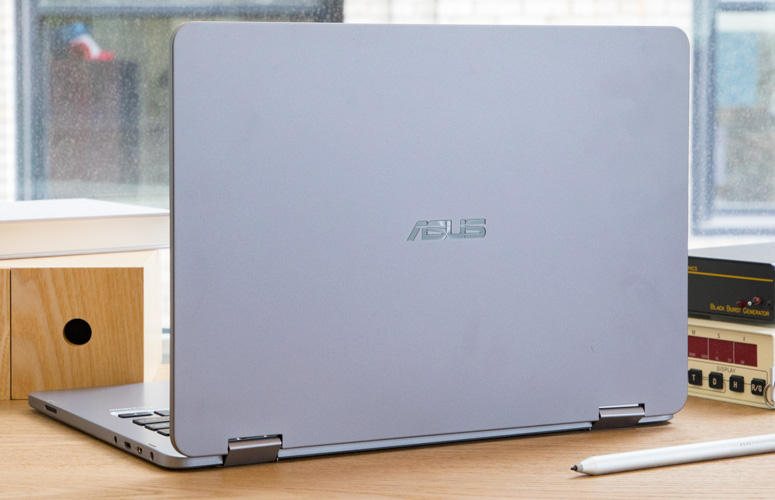
What stands out about the VivoBook's design is its flexibility. Two hinges rotate the display back 360 degrees, converting the machine into a tablet, or you can twist the laptop into tent mode for viewing movies or slideshows. A shiny, silver Asus logo is centered on the lid and SonicMaster branding adorns the deck.
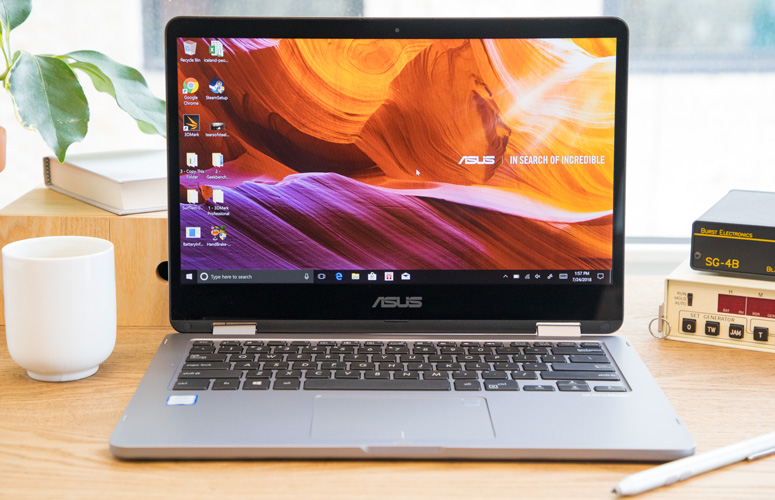
Despite its simple design, the VivoBook doesn't look cheap. Its sleek, refined curves and textured-aluminum materials give it a deceptively premium appearance. I wouldn't be embarrassed to carry it to school or work.
Its sleek, refined curves and textured-aluminum materials give the VivoBook Flip 14 a deceptively premium appearance.
However, while we don't expect premium materials at this price, the build quality of the VivoBook Flip 14 is questionable. The deck flexed under pressure, and a soft tap caused the display to wobble. We also have concerns about the machine's construction. The hinge on our review unit was bent, causing the lid to be misaligned from the deck when closed. Asus sent us a replacement unit, and while it didn't exhibit the same issue, the lid didn't sit flush with the sides of the base.
The VivoBook Flip 14 is relatively lightweight, at 3.2 pounds. The Acer Spin 3, another sub-$500 convertible, weighs 3.8 pounds. And at 12.9 x 8.9 x 0.6 inches, the VivoBook is more compact than the 13.2 x 9.1 x 0.8 inch Spin 3.
Ports
The VivoBook Flip 14 has a strange assortment of ports. On the left side is a micro USB 2.0 port, something we've never seen on a laptop. Asus says this port is for data transfer with mobile devices, but we doubt anyone uses a micro USB-to-micro USB cable.
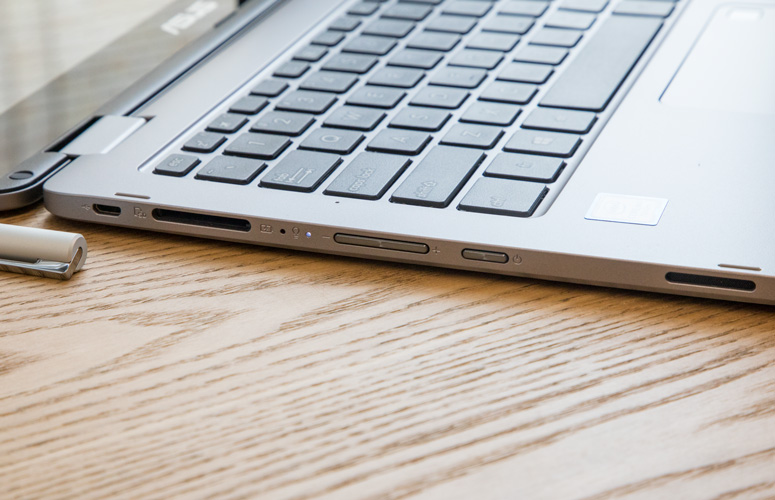
A more useful feature is the SD card slot that sits next to a volume rocker and a power button.
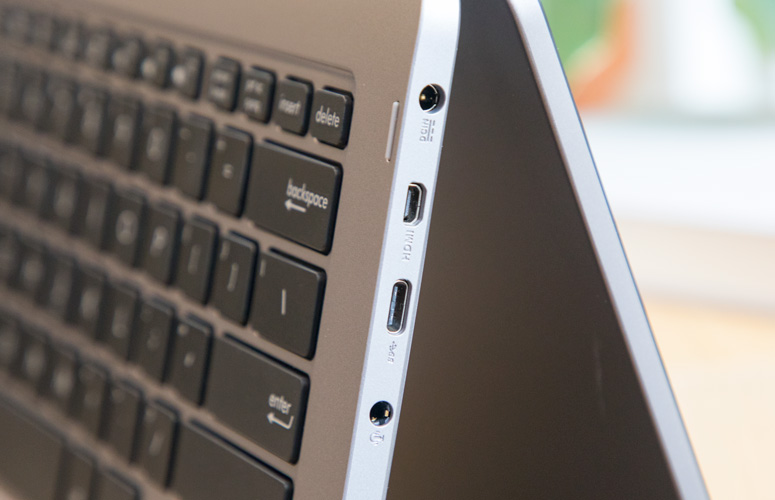
The right side of the machine includes a micro HDMI, a USB 3.1 Type-C port, a headphone/mic jack and a DC connector.
Display
The 1920 x 1080-resolution touch screen display on the Asus VivoBook Flip 14 isn't very good, but we've seen worse at this price. When I watched the trailer for the upcoming film Mile 22, Mark Wahlberg looked rather bland. When the action got going, the display's weaknesses became more apparent. What should have been an intense fight scene with exploding colors was instead a washed-out battleground.
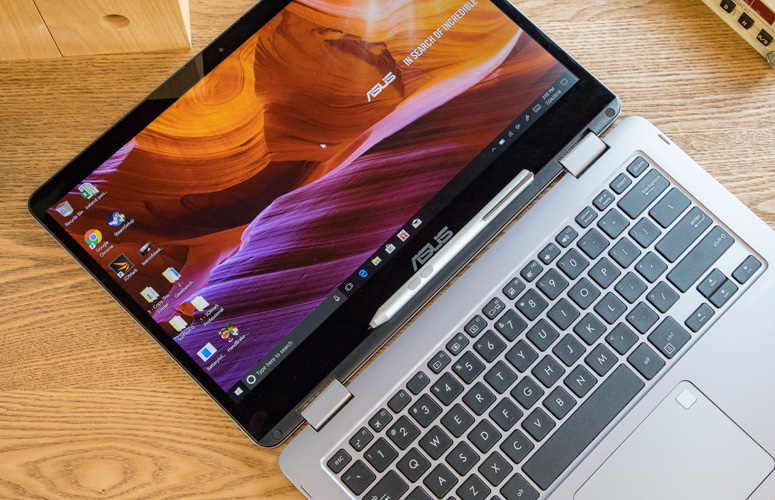
I also would have liked more contrast between the glowing orange fire and blue atmosphere in the trailer for Godzilla: King of the Monsters. Fortunately, the VivoBook 14's 1080p panel is sharp. I could clearly see falling wreckage left by the destructive monster as well as individual drops of water running down Kyle Chandler's face. When I visited my favorite news sites, their white background leaned red. I was able to correct the white balance issue using Microsoft's color-calibration software.
Unsurprisingly, the VivoBook Flip 14 produced only 69 percent of the sRGB color gamut. That's a bit worse than the Acer Spin 3's 70 percent and Lenovo Flex 6's 71 percent. It is nowhere near the mainstream laptop category average of 91 percent or the Acer Aspire E 15's exceptional 159 percent. That's especially disappointing considering last year's model produced well over 100 percent.
MORE: Laptops with the Best Display Brightness
The VivoBook Flip 14 doesn't get very bright, either. It reached a maximum brightness of 221 nits, which is just short of both the Acer Spin 3's score (226 nits) and the mainstream laptop average (231 nits). The Lenovo Flex 6 (206 nits) and last year's Acer Aspire E 15 (215 nits) were even dimmer. The display also looks faded when viewed from an angle, and its glossy finish is very reflective.
I didn't have any problems tapping on the touch screen to navigate the web or draw pictures using the SketchBook app.
Keyboard and Touchpad
I wouldn't want to write a report using the VivoBook Flip 14's island-style keyboard. The keys are on the small side, and they feel soft and mushy when pressed. At 1 millimeter, key travel is short of our minimum 1.5mm preference. I found myself frequently bottoming out, an uncomfortable situation in which your fingers hit the base after you've fully depressed the keys. I also wish the keyboard were backlit.
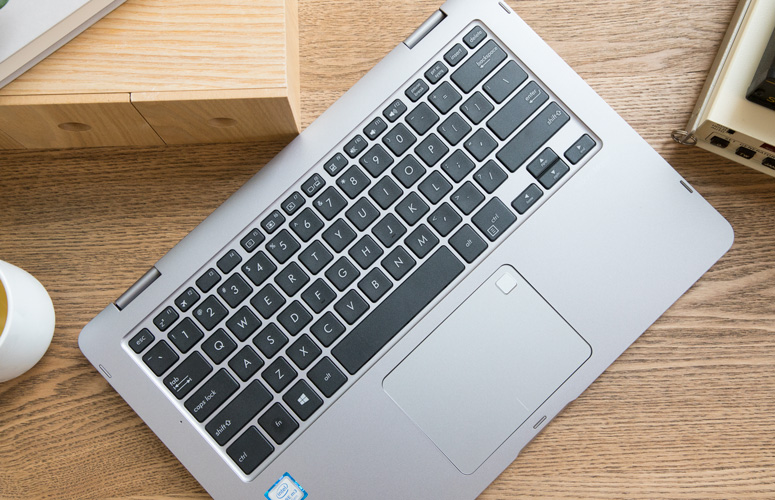
While the keyboard isn't comfortable to use for long sessions, its low actuation force of 61 grams helped me complete the 10fastfingers.com typing test at 109 words per minute with an accuracy of 96 percent. That equals my 109 wpm average and is right around my 95 percent accuracy average.
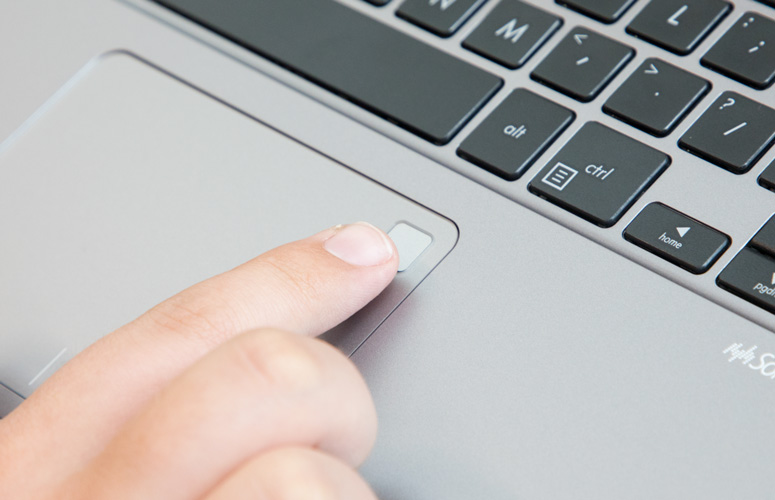
I had no issues using the touchpad to execute gestures, like pinch-to-zoom or switching to task view with a three-finger swipe up. However, I did notice a slight lag when opening certain features, like Cortana.
Audio
The VivoBook 14's side-firing speakers aren't notably loud, but they did a good job filling a small conference room. When I listened to "Lonely Town," Brandon Flowers' vocals sounded somewhat distant, but the clarity and separation of the instruments helped reproduce the funky '80s vibe the Killers' lead singer was going for.
MORE: Best Laptops Under $500
The VivoBook did a better job bringing Drake's vocals to the forefront when I listened to "God's Plan," but a severe lack of bass drained the song of energy. The VivoBook failed to redeem itself when I listened to the Skrillex remix of Avicii's "Levels." The bass sounded like a cacophony of symbols clashing together instead of a low thud.
Performance
With an Intel Core m3-7Y30, 4GB of RAM and 64GB of eMMC storage, the VivoBook Flip 14 can handle basic tasks but buckles under a heavy workload. The laptop slowed down significantly when I launched a dozen Google Chrome tabs and watched a 1080p YouTube video. Even certain Windows processes, like enabling Cortana or opening the Start Menu, were delayed.
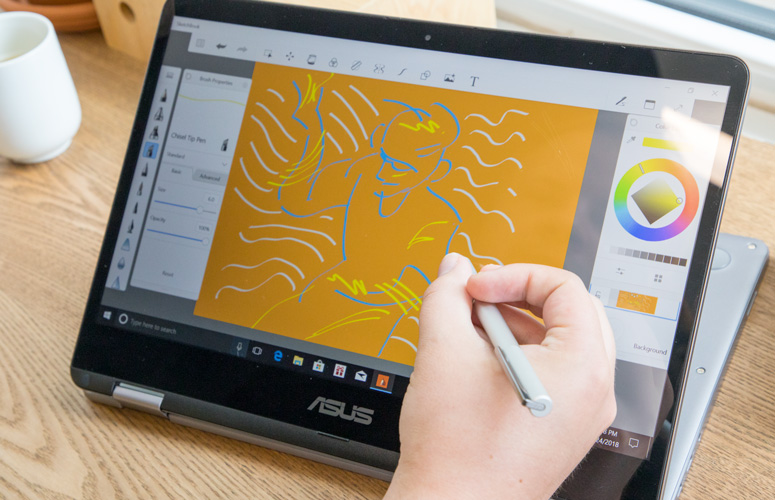
On the Geekbench 4 overall performance test, the VivoBook Flip 14 scored 5,507. That mark is far behind that of the Core i3-equipped Acer Spin 3 (7,658) and the mainstream laptop average (8,423). However, the Core i3-7100U-equipped Acer E 15 (5,408) and Lenovo Flex 6 (3,072) with a Celeron N4000 CPU scored even lower.
With an Intel Core m3 CPU, 4GB of RAM and 64GB of eMMC storage, the VivoBook Flip 14 can handle basic tasks, but it buckles under a heavy workload.
It took the VivoBook 3 minutes and 35 seconds to match 65,000 names with their corresponding addresses in our Excel macro test. The Acer Spin 3 accomplished the same task in 2:31, and the mainstream laptop average is even quicker, at 2:01. The VivoBook did outpace the Lenovo Flex 6, which took a leisurely 5:56.
The VivoBook performed slightly better in our file-transfer test, duplicating a 4.97GB mixed-media file in 2 minutes and 53 seconds for a rate of 29.4 megabytes per second. The Acer Spin 3 took longer to duplicate the files (28.6 MBps), while the Lenovo Flex 6 (35.8 MBps) and Acer Aspire E 15 (36.6 MBps) were a bit quicker. None of these laptops' scores were anywhere near the mainstream category average (138.7 MBps).
MORE: Best Hard Drive Speed
Given the VivoBook Flip 14's low-end components, it's no surprise that this machine took almost an hour to transcode a 4K video to 1080p using the HandBrake app. At a sluggish 52:34, the Flip 14 was significantly slower than the Acer Spin 3 (34:59) and the mainstream laptop average (26:37).
Graphics
The Asus VivoBook Flip 14's Intel HD Graphics 615 is only powerful enough to play web-based games or less-demanding titles at lower settings. It ran Dirt 3 at 30 frames per second, which matches our playability cutoff. The Acer Spin 3 powered the same racing title at 38 fps, while the Lenovo Flex 6 produced an unplayable 14 fps. The mainstream laptop average is 49 fps.
MORE: Best Graphics Performance
The VivoBook scored a 51,586 on Ice Storm Unlimited, a graphics benchmark test. That is well short of the Acer Spin 3's score (70,127) and the mainstream laptop average (72,404), but destroys the Lenovo Flex 6's result (25,678) and even outdoes the Acer Aspire E 15's showing (49,211).
Battery Life
The VivoBook Flip 14's battery life is slightly below par. It lasted 7 hours and 23 minutes on the Laptop Mag Battery Test, which involves continuous web surfing over Wi-Fi at 150 nits of brightness. That is significantly better than the Acer Spin 3's time of just 6 hours. But the Flip 14 was outperformed by the 11-inch Lenovo Flex 6 (9:11) and Acer Aspire E 15 (7:48). The mainstream laptop average is a few minutes longer, at 7:37.
Webcam
The webcam on the VivoBook Flip 14 is dismal. The image it captured of my face was so out of focus that I wiped the lens thinking it was smudged. Alas, no amount of cleaning was going to fix the 640 x 480 selfie cam. Adding insult to injury, my gray shirt was a deep black, and my face was so dark that it looked like I was wearing eyeliner.
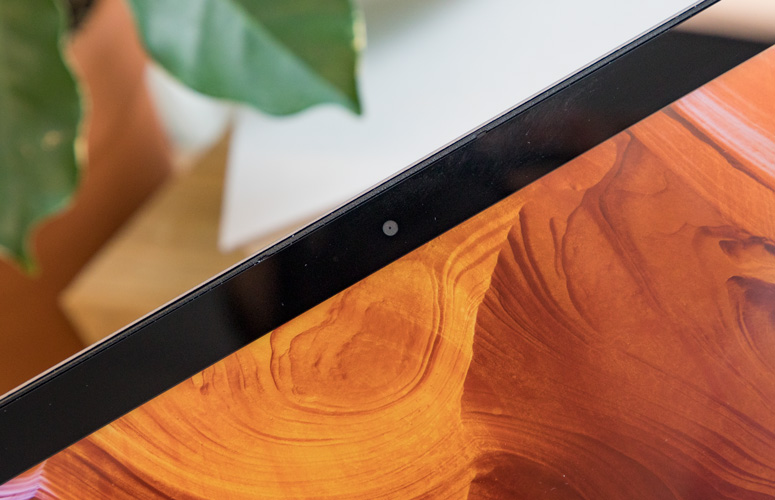
Heat
The Asus VivoBook Flip 14 remained relatively cool after streaming a full-screen video for 15 minutes at 1080p resolution. The touchpad was a chilly 80.5 degrees Fahrenheit, and the location between the G and H keys warmed to 91.5 degrees, which is still below our 95-degree comfort threshold. The bottom, however, reached a toasty 105 degrees.
Software and Warranty
The Asus VivoBook Flip 14 is a hotbed for preinstalled software. The 2-in-1's Windows 10 Home OS comes with a folder of Asus utilities, including Hello, Install, Utility, Splendid and WinFlash. Asus Install will automatically update your device with the latest drivers, while Asus Splendid lets you change the color temperature of the display.
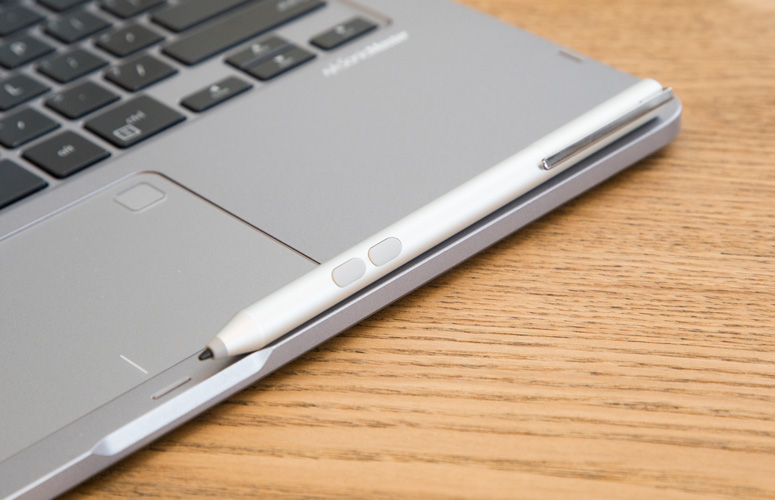
There are also separate Asus programs for adjusting the battery mode, registering the laptop and receiving special offers on Windows apps. Another app, called MyAsus Service Center, gives you quick access to customer service and instructional videos. Other bloatware taking up limited storage space includes the McAfee Security app and a Microsoft Office knockoff called WPS Office.
MORE: Laptops with the Longest Battery Life
But wait, that's not all. Microsoft brings its own bloatware to the table. Making an undesired return are the Candy Crush Saga games and a Netflix app.
Configurations
Our $449 review unit came equipped with an Intel Core m3-7Y30 processor, 4GB of RAM and 64GB of eMMC storage. You can double the storage amount for $50 more.
Bottom Line
The $449 VivoBook 14 is one to skip. While it has an elegant and flexible design, the 2-in-1 falls short where it matters most. Its 1080p display looks dull and dim, and the weak Core m3 processor struggled to run multiple tabs in our testing. A blurry webcam and uncomfortable keyboard don't help the cause, either. Ultimately, we expect more, even at this price.
A better alternative is the Acer Spin 3. Its Core i3 CPU offers faster performance, though you get less battery life than with the Asus. If you can live with a smaller display, you might like the Lenovo Flex 6 11, which lasts a lot longer on a charge than the VivoBook 14. If you don't need a convertible laptop, we recommend the Acer Aspire E 15. At $349, it costs even less than the VivoBook but has a more vivid display and stronger battery life.
Overall, the VivoBook 14 looks pretty sleek for the money, but it doesn't do enough to warrant a recommendation.
Credit: Laptop Mag
ASUS VivoBook Flip 14 Specs
| Bluetooth | Bluetooth 4.1 |
| Brand | ASUS |
| CPU | Intel Core m3-7Y30 |
| Card Slots | SDXC |
| Company Website | https://www.asus.com/us/ |
| Display Size | 14 |
| Graphics Card | Intel HD Graphics 615 |
| Hard Drive Size | 64GB |
| Hard Drive Type | eMMC |
| Highest Available Resolution | 1920 x 1080 |
| Native Resolution | 1920x1080 |
| Operating System | Windows 10 Home |
| Ports (excluding USB) | SD card slot, Combo Headphone/Mic Jack, Fingerprint Scanner, MicroUSB, micro HDMI, USB 3.1 with Type-C |
| RAM | 4GB |
| RAM Upgradable to | 8GB |
| Size | 12.9 x 8.9 x 0.6 inches |
| Touchpad Size | 4.0 x 2.8 inches |
| USB Ports | 4 |
| Warranty/Support | 1 year |
| Weight | 3.22 pounds |
| Wi-Fi | 802.11 a/b/g/n/ac |
| Wi-Fi Model | Qualcomm Atheros QCA9377 |
Phillip Tracy is the assistant managing editor at Laptop Mag where he reviews laptops, phones and other gadgets while covering the latest industry news. After graduating with a journalism degree from the University of Texas at Austin, Phillip became a tech reporter at the Daily Dot. There, he wrote reviews for a range of gadgets and covered everything from social media trends to cybersecurity. Prior to that, he wrote for RCR Wireless News covering 5G and IoT. When he's not tinkering with devices, you can find Phillip playing video games, reading, traveling or watching soccer.

